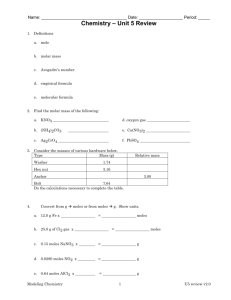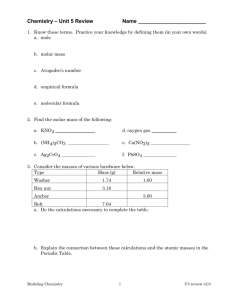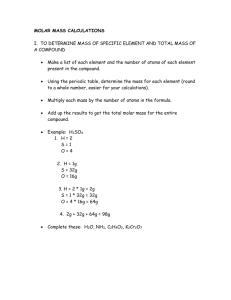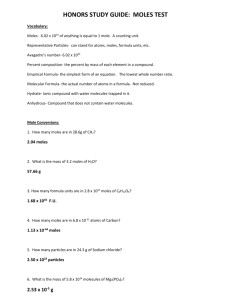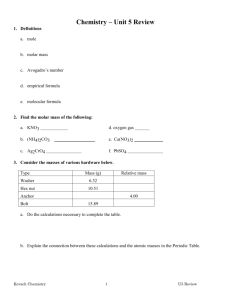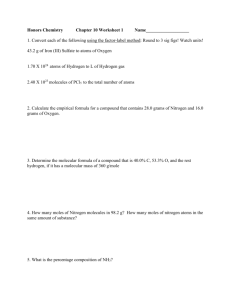AP WORKSHEET 4s: Calculations Summary TYPE 1: Those
advertisement
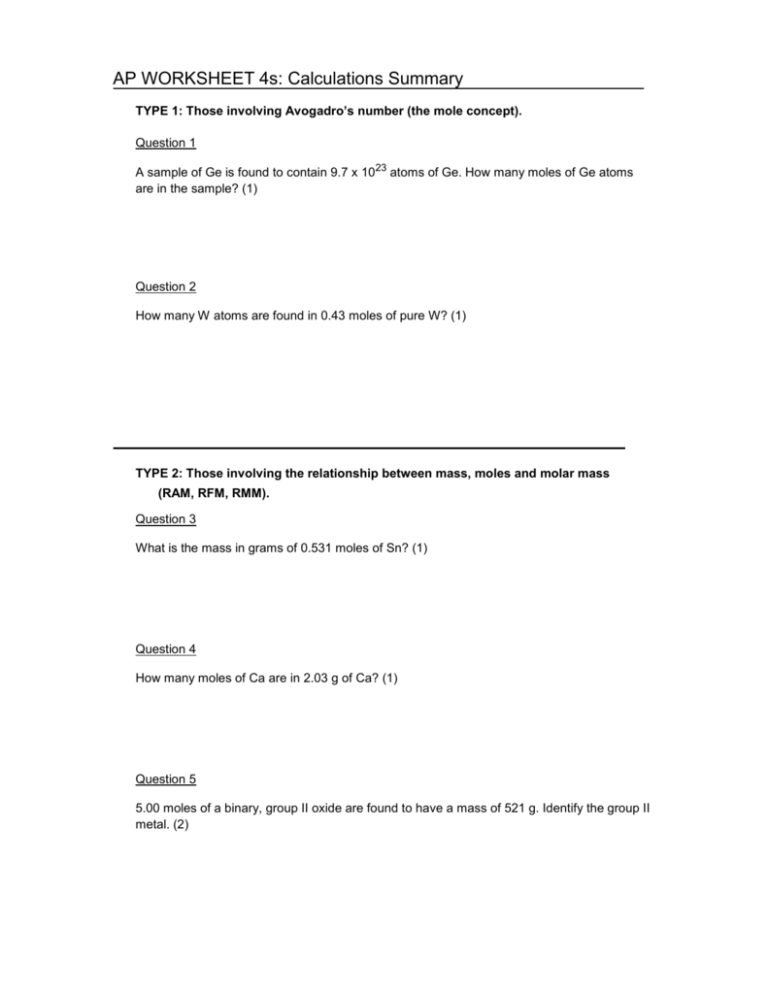
AP WORKSHEET 4s: Calculations Summary TYPE 1: Those involving Avogadro’s number (the mole concept). Question 1 A sample of Ge is found to contain 9.7 x 1023 atoms of Ge. How many moles of Ge atoms are in the sample? (1) Question 2 How many W atoms are found in 0.43 moles of pure W? (1) TYPE 2: Those involving the relationship between mass, moles and molar mass (RAM, RFM, RMM). Question 3 What is the mass in grams of 0.531 moles of Sn? (1) Question 4 How many moles of Ca are in 2.03 g of Ca? (1) Question 5 5.00 moles of a binary, group II oxide are found to have a mass of 521 g. Identify the group II metal. (2) TYPE 3: Those combining types #1 & #2. Question 6 How many Ta atoms are found in a 1.231 g sample of Ta? (2) Question 7 What is the mass of 8.11 x 1023 atoms of Sulfur? (2) Question 8 What mass of Cu atoms have the same number of atoms as there are in a 4.21g sample of Si? TYPE 4: % by Mass Composition. Question 9 Calculate the percent by mass composition of dimethylether, CH3OCH3. (2) Question 10 What is the percent by mass composition of aluminum sulfate? (2) Question 11 A compound that contains a complex ion has the formula Al 4[Fe(CN)6]3. What is the percent by mass composition of this compound? (2) TYPE 5: Empirical formula. Question 12 A compound containing silver and chlorine contains 75.3% Ag. What is the empirical formula of the compound? (2) Question 13 In a vigorous chemical reaction, 1.403 g of sodium metal is completely reacted with 1.159 g of fluorine gas. What is the empirical formula of the compound formed? (3) TYPE 6: Molecular formulae from empirical formulae. Question 14 What is the molecular formula of hydrocarbon that has an empirical formula of CH and a molecular mass of 78 gmol-1? (1) Question 15 A compound contains 48.65% carbon, 8.108% hydrogen, and the remainder oxygen. The molecular mass of this compound is approximately 74.00 g/mol. What is the empirical formula? What is the molecular formula? (3) TYPE 7: Combustion analysis. Question 16 The combustion of 4.000 g of a compound that contains only C, H, N and Br yields 3.826 g of CO2 and 2.087 g of H2O. Another sample of the compound with a mass of 3.111 g is found to contain 1.803 grams of Br. What is the empirical formula of the compound? (6) TYPE 8: % Yield. Question 17 Propane will combust according to the reaction below. If 11.1 g of Propane produces 23.3 g of CO2 when burned in excess oxygen, what is the % yield? (3) C3H8 + 5O2 3CO2 + 4H2O TYPE 9: Limiting reactant. Question 18 Consider the reaction between Iron and anhydrous Copper (II) sulfate that produces Iron (II) sulfate and Copper metal. (a) Write an equation for the reaction. (2) (b) If 120. g of Fe are reacted with 200. g of Copper (II) sulfate, identify the limiting reagent. Which reagent is in excess? (2) (c) Calculate the mass of Copper formed. (2) (d) How much of the excess reagent is left over at the end of the reaction? (2) Type 10: Analysis of hydrated salts. Question 19 . Barium Chloride is found as a hydrated salt, BaCl2 xH2O. A student carefully heats 2.50 g of the salt to a constant mass of 2.13 g. Find x. (4) TYPE 11: Moles and reacting ratios (including solutions). Question 20 Calcium hydrogen carbonate, Ca(HCO3)2, reacts with HCl according to the equation below. Ca(HCO3)2 + 2HCl CaCl2 + 2CO2 + 2H2O (a) What volume of 0.235 M HCl solution must be present to totally react with 0.140 moles of the calcium compound? (2) (b) How many moles of water are produced when 0.491 g of the calcium compound combines with excess HCl? (2) TYPE 12: Dilution. Question 21 Calculate the volume of 0.120 M sulfuric acid that must be diluted with water to produce 3.00 L of 0.018 M sulfuric acid. (2)


